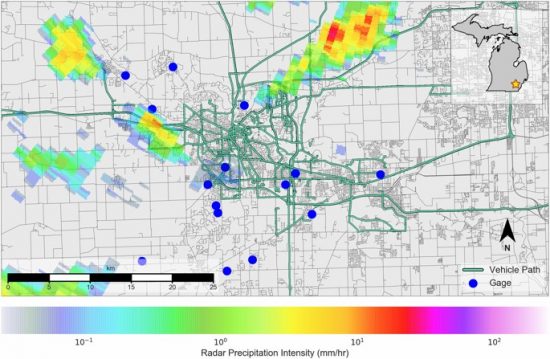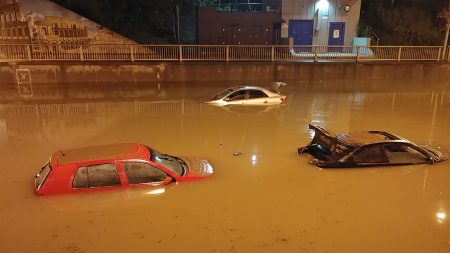January 23, 2019 – A novel paper entitled “Windshield wipers on connected vehicles produce high-accuracy rainfall maps,” authored by Matthew Bartos, Department of Civil and Environmental Engineering, and Hyongju Park, Department of Mechanical Engineering, both at University of Michigan – Ann Arbor, propose to use networked vehicles on roads to provide real-time environmental data on an unprecedented scale.
Based on the analysis of 70 connected vehicles and their windshield wipers, they have produced a data set that provides accurate methods of measuring precipitation including the timing, location, and amounts surpassing traditional weather gauges. In their conclusions, they note that wiper measurements are stronger predictors of rainfall measurement that get missed by stationary gauges. And they propose that this method of data gathering would enhance rainfall maps “to improve flood warnings and facilitate real-time operation of stormwater infrastructure.”
The problem the authors are attempting to address is urban flash floods. Flash floods are today the number one cause of fatalities from natural disasters worldwide. The lack of accurate real-time data to forecast a potential flash flood occurrence to provide a window of safety between one and 15 minutes could be facilitated by measuring what falls on car windshields using the wipers.
The confluence of the rise of connected and autonomous vehicles represents an unprecedented opportunity for doing this type of real-time precision precipitation measurement. In the paper the authors write:
“Windshield wiper activity offers a novel means to detect the location and timing of rainfall with enhanced precision. When used in conjunction with modern signal processing techniques, wiper-based sensing offers several attractive properties: (i) vehicles achieve vastly improved coverage of urban areas, where flood monitoring is important; (ii) windshield wiper intensity is easy to measure and requires little overhead for processing (as opposed to video or audio data); and (iii) vehicle-based sensing can be readily scaled as vehicle-to-infrastructure communication becomes more widespread.”
They go on describing how many new vehicles use optical rain sensors to activate windshield wipers. My 2017 Toyota RAV4 is one of these. I never turn on the windshield wipers because they go on automatically when they detect rain and then increase their frequency of swipes as the rain intensifies. That’s because the optical rain sensors have the ability to directly measure rain intensity. Collecting the data produced by these sensors can provide accurate measurements of precipitation by locality.
In comparing stationary weather gauge precipitation collection, radar, and windshield wiper measurements for three storm events the authors conclude that the latter produced the most accurate measure of a rainfall event detecting even “intermittent changes in rainfall…on the order of seconds” when compared to radar and gauge measurements which provided data reporting in 5-minute increments.

The authors aren’t proposing that radar and weather gauge methods of measuring precipitation be scrapped. Rather they believe that including vehicle-based measurements in the arsenal of forecasting tools will produce much more meaningful data in real-time. And in the event of a rainfall event that produces a flash flood, seconds may count whereas minutes may not provide a fast enough forecast for people to stay off thoroughfares where flooding is imminent, and away from stormwater channels and rivers that may suddenly crest.
















